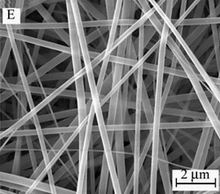| [1] Hong, X.-Y.; Yun, Z.-L.; Fang, Y.; Shuai, J.-Z.; Xi, L.-S. Mater. Sci. Forum 2011, 688, 74.[2] Zhang, H.; Song, H.-W.; Dong, B.; Han, L.-L.; Pan, G.-H.; Bai, X.; Fan, L.; Lu, S.-Z.; Zhao, H.-F.; Wang, F. J. Phys. Chem. C 2008, 112, 9155.[3] Liao, F.-H.; Li, J.-R. Colloids Surf. A 2011, 10, 1102.[4] Huang, L.-B.; Cheng, L.-H.; Yu, H.-Q.; Zhou, L.; Sun, J.-S.; Zhong, H.-Y.; Li, X.-P.; Zhang, J.-S.; Tian, Y.; Zheng, Y.-F.; Yu, T.-T.; Wang, J.; Chen, B.-J. Physica B: Condensed Matter 2011, 406, 2745.[5] Wang, H.-H.; He, P.; Yan, H.-G.; Gong, M.-L. Sens. Actuators B: Chem. 2011, 156, 6. [6] Yuan, J.-L.; Wang, G.-L. J. Fluoresc. 2005, 15, 559.[7] Broda, C. R.; Lee, J. Y.; Sirivisoot, S.; Schmidt, C. E.; Harrison, B. S. J. Biomed. Mater. Res. Part A 2011, 98, 509.[8] MacDiarmid, A. G.; Yang, L.-S.; Huang, W.-S.; Humphrey, B. D. Synth. Met. 1987, 18, 393.[9] Dewberry, D. W. J. Electrochem. Soc. 1985, 132, 1022.[10] Barros, R. A.; Martins, C. R. Synth. Met. 2005, 155, 35.[11] Yoshioka, Y.; Jabbour, G. E. Synth. Met. 2006, 156, 779.[12] Chung, Y.-W.; Avraham, B. Polym. Eng. Sci. 1997, 37, 738.[13] Dong, X.-T.; Liu, L.; Wang, J.-X.; Liu, G.-X. Chem. J. Chin. Univ. 2010, 31, 20. (董相廷, 刘莉, 王进贤, 刘桂霞, 高等学校化学学报, 2010, 31, 20.)[14] Sun, X.; Dong, X.-T.; Wang, J.-X.; Liu, G.-X. Chem. J. Chin. Univ. 2011, 32, 2262. (孙霞, 董相廷, 王进贤, 刘桂霞, 高等学校化学学报, 2011, 32, 2262.)[15] Song, C.; Dong, X.-T.; Wang, J.-X.; Liu, G.-X. Chem. J. Chin. Univ. 2011, 32, 1673. (宋超, 董相廷, 王进贤, 刘桂霞, 高等学校化学学报, 2011, 32, 1673.)[16] Li, Y.-J.; Cao, T.-P.; Wang, C.-H.; Shao, C.-L. Chem. J. Chin. Univ. 2011, 32, 2490. (李跃军, 曹铁平, 王长华, 邵长路, 高等学校化学学报, 2011, 32, 2490.)[17] Li, Y.-J.; Cao, T.-P.; Sun, X.-L.; Shao, C.-L. Chem. J. Chin. Univ. 2010, 31, 16. (李跃军, 曹铁平, 孙新丽, 邵长路, 高等学校化学学报, 2010, 31, 16.)[18] Li, X.; Zhao, Y.-Y.; Lu, X.-F.; Wang, H.-Y.; Wang, C. Chem. J. Chin. Univ. 2006, 27, 2002. (李响, 赵一阳, 卢晓峰, 王海鹰, 王策, 高等学校化学学报, 2006, 27, 2002.)[19] Huang, H.-M.; Li, Z.-Y.; Yang, F.; Wang, W.; Wang, C. Chem. J. Chin. Univ. 2007, 28, 1200. (黄绘敏, 李振宇, 杨帆, 王威, 王策, 高等学校化学学报, 2007, 28, 1200.)[20] Teo, W.-E.; Inai, R.; Ramakrishna, S. Sci. Technol. Adv. Mater. 2011, 12, 13002.[21] Bellan, L. M.; Craighead, H. G. Polym. Adv. Technol. 2011, 22, 304.[22] Hou, Y.; Dong, X.-T.; Wang, J.-X.; Liu, G.-X.; Li, L.-H. Chem. J. Chin. Univ. 2011, 32, 225. (侯远, 董相廷, 王进贤, 刘桂霞, 李乐慧, 高等学校化学学报, 2011, 32, 225.)[23] Song, C.; Dong, X.-T.; Wang, J.-X.; Liu, G.-X. Acta Chim. Sinica 2011, 69, 1186. (宋超, 董相廷, 王进贤, 刘桂霞, 化学学报, 2011, 69, 1186.)[24] Wang, J.-X.; Zhang, H.; Dong, X.-T.; Xu, S.-Z.; Liu, G.-X. Acta Chim. Sinica 2010, 68, 501. (王进贤, 张贺, 董相廷, 徐淑芝, 刘桂霞, 化学学报, 2010, 68, 501.)[25] Wang, J.-X.; Dong, X.-T.; Cui, Q.-Z.; Liu, G.-X.; Yu, W.-S. J. Nanosci. Nanotechnol. 2011, 11, 2514.[26] Song, C.; Dong, X.-T.; Wang, J.-X.; Liu, G.-X. Acta Chim. Sinica 2011, 69, 2471. (宋超, 董相廷, 王进贤, 刘桂霞, 化学学报, 2011, 69, 2471.)[27] Zhang, D.-M.; Chang, J. Nano Lett. 2008, 8, 3283.[28] Edwards, M. D.; Mitchell, G. R.; Mohan, S. D.; Olley, R. H. Eur. Polym. J. 2010, 46, 1175.[29] Jin, H.-L.; Dong, X.-T.; Xu, S.-Z.; Wang, J.-X. New Chem. Mater. 2008, 36, 49. (金怀龙, 董相廷, 徐淑芝, 王进贤, 化工新型材料, 2008, 36, 49.)[30] Cao, T.-P.; Li, Y.-J.; Wang, Y.; Shao, C.-L. Acta Polym. Sinica 2010, (12), 1464. (曹铁平, 李跃军, 王莹, 邵长路, 高分子学报, 2010, (12), 1464.)[31] Zhang, Q.-H.; Wang, X.-H.; Jing, X.-B. Chem. World 2001, 53, 242. (张清华, 王献红, 景遐斌, 化学世界, 2001, 53, 242.) [32] Kim, J.; Kwon, S.; Ihm, D. W. Curr. Appl. Phys. 2007, 7, 205.[33] Wang, Z.-X.; Chen, H.; Tan, M.-J. Spectrosc. Spectr. Anal. 2005, 25, 1106. (王正祥, 陈洪, 谭美军, 光谱学与光谱分析, 2005, 25, 1106.) |
